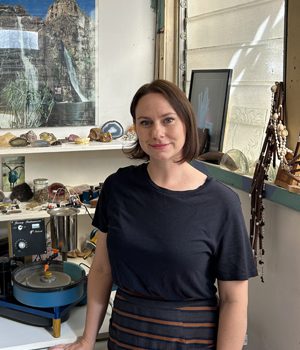In Conversation with Juan Castro
In his new exhibition ‘Celestial‘, Juan Castro turns to the sacred architecture and soft, symbolic colour palettes of European cathedrals for inspiration. Known for drawing on mythology, history, and anthropology, Juan shifts his focus to structure, light, and material in this body of work – offering a meditative reflection on form, memory, and meaning. In this conversation, Juan speaks about his creative process, the emotional and spiritual resonance of jewellery, and how adornment continues to hold space for cultural storytelling today.
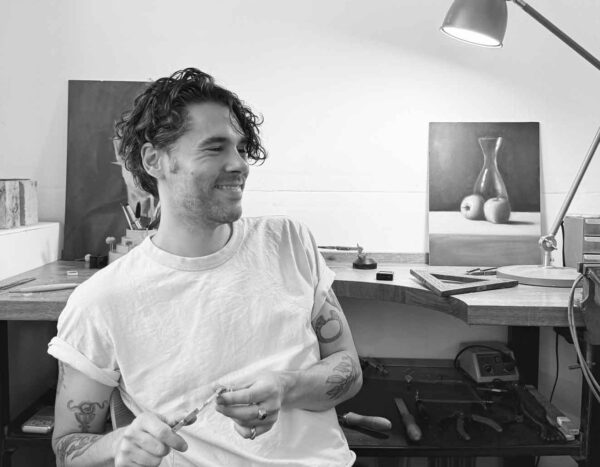
What initially drew you to the sacred architecture and soft colour palettes of European churches as the central inspiration for ‘Celestial’?
It’s something I’ve seen since I was a child and from where I’ve always taken references to design my pieces. I revisited all of it, but this time I focused on something I had overlooked before – the structure.
Blue is the colour that always catches my attention when I step into a cathedral. In Catholic religious art, it represents heaven, purity, eternity, and the divine. I wanted to pair this symbolic meaning with the materials used in this collection to elevate them.
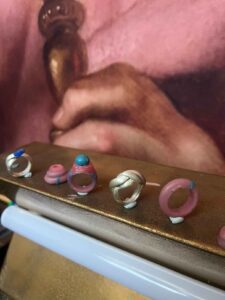
Your previous work incorporates mythology, history, and anthropology. How does ‘Celestial’ continue – or depart from – those themes?
In most of my previous work, I focused on symbolic elements and adornments. In Celestial, the focus is on the structure and architecture – the foundations that hold and host the paintings, objects, or sculptures. All of them are full of detail and show the craftsmanship from which I’ve taken elements in the past. Columns, arches, round and smooth surfaces – these are the core of ‘Celestial’.
The flowing lines and soft curves in this collection are a shift from some of your past pieces. What was it like exploring these forms?
What really attracted me to experimenting with the simplicity of the curve was the way light bounces off the surface. My design approach has always focused on building layers and using organic textures.
With ‘Celestial’, I started from a rounded surface with little detail or texture, embracing the material and how light reflects on it. I also played with volume and the weight of the pieces – something that is usually very controlled when working with materials like gold.
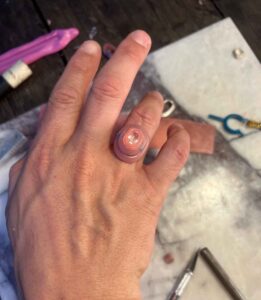 Can you talk about the materials you’ve chosen for ‘Celestial’—sterling silver, touches of yellow gold, and muted gemstone tones? What was your intention in choosing these materials?
Can you talk about the materials you’ve chosen for ‘Celestial’—sterling silver, touches of yellow gold, and muted gemstone tones? What was your intention in choosing these materials?
As a jeweller, I’ve often overlooked some materials. I’ve used silver before, but usually hidden behind patinas or as a base to support other precious metals. I feel like, in a way, I owed something to silver. ‘Celestial’ is about celebrating the material – enjoying how alive it is and the way it tarnishes and changes with time. The touches of gold support the silver in this collection, and the use of muted precious stones adds depth without taking attention away from the metal. Champagne diamonds and natural zircon melt into the different finishes – linished or semi-polished – enriching each piece.
You have a background in social and cultural anthropology. How does this influence the way you approach jewellery design?
I approach jewellery design from a more holistic perspective. It’s not just about creating a beautiful object – there’s meaning and research into my own culture and upbringing.
“Using elements from different parts of my culture, especially aesthetic ones, allows me to present them in a contemporary light – without stripping them of their original meaning, and always with respect for where they come from.”
The installation for ‘Celestial’ aims to evoke the experience of entering a temple. How do you see jewellery functioning within that kind of sacred or ritualistic space?
Jewels have always been present in temples or sacred spaces. They are symbols of power, wealth, or belonging. They create emotions. In Spanish, the word for jewel is joya, which comes from the French word meaning joy or happiness. Joya is the feeling produced by something beautiful and valuable.
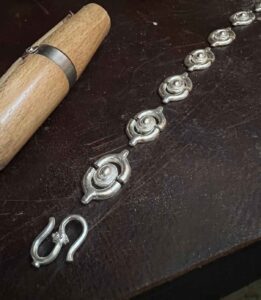
There is nothing more beautiful or valuable in any religion than its own beliefs and dogmas. We can see how Catholic churches are richly embellished with gold and gemstones; how elaborate and beautiful the details are in mosques; or how stunning and golden Buddhist temples are.
“Jewels in sacred spaces are the human, visual translation of the value of their beliefs.”
What do you hope people feel when they see your pieces?
I hope they feel a connection with the pieces – something that evokes memories or emotions from their own experiences. They might see features of a building they visited on a trip, or be reminded of an object or a piece of jewellery that belonged to someone they loved. Even though the pieces are full of my own references as a designer, there is space for others to project their own memories and interpretations.
Your pieces often sit in this interesting space between ancient and contemporary design. How do you find that balance without leaning too far in either direction?
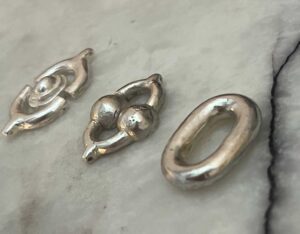
Through a lot of research and practice. Design is about knowing how to distinguish between your references and the idea that emerges after everything has been filtered through your experiences. I believe there is a humble side to accepting that you are not creating something entirely new – you are filtering references through your unique perspective. In my case, that perspective is contemporary, shaped by my memories. For example, the textures I used in previous collections are a reflection of the volcanic landscapes of my home island, while the forms come from research into ancient jewellery.
Do you see adornment today, particularly through pieces like those in ‘Celestial’, as continuing some of the ancient functions of jewellery, such as spiritual or social symbolism?
Jewels create emotions, and emotions create feelings. Feelings produce thoughts, and together they form the foundation of beliefs and dogmas which are full of rituals and symbolism. The meaning and use of jewellery will always be embedded in our human nature. The materials, gemstones, and values may have changed or varied throughout history, but what jewellery makes us feel is something deeply intrinsic to our emotional experience as social beings.


